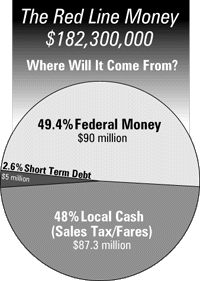Rail-ly Expensive
Fri., April 4, 1997
Capital Metro Shows Us the Money

|
With the combined $919.9 million price tag for the Red, Orange, and Green lines running almost seven times more than Capital Metro's $118.8 million 1997 budget, one might wonder what magical wellspring of cash Cap Met officials are planning to tap for the costs of launching light rail. Obviously the answer is big time debt, but officials are also counting on federal money to help round out the financial picture. The agency is also banking on that infamous penny of your sales tax dollars, as well as the 50 cents at the fare box, meaning that neither tariff is likely to decrease before the rail lines are completed in 2010. The way things are shaping up for Cap Met, they are going to need every nickel and dime they can scrape together to afford the ambitious rail project.
Outside of construction costs, the outlay for studying light rail has already been considerable. According to figures provided by Capital Metro, $1.77 million has already been spent this year, of which a half a million dollars was spent on the RegioSprinter demonstration. As for how much has been spent studying light rail since the inception of Capital Metro in 1985, Alan Pegg, Chief Financial Officer at Cap Met, confirmed that around $5 million had been spent on studies in the past 12 years.
Despite the fact that Cap Met has always managed to run itself in the black, the agency is now poised for a swan dive into a pit of debt. In order to build the first three lines, Capital Metro is slated to borrow $290 million, mostly in the form of bonds authorized through public referendum. And borrowing may have to increase to fill the gap if all the agency's federal dollar chickens don't hatch. Cap Met critics, however, say that allowing the agency to issue any sort of debt is a mistake. "Once you allow a taxing authority to issue debt, god couldn't do anything about them. You have to leave them in existence for perpetuity," complains Gerald Daugherty, founder of Reclaim Our Allocated Dollars (ROAD), which has fought to roll back Cap Met's one-cent sales tax allocation.
But even the critics must concede that the Red Line, at least, can be built without long term debt, and at a considerable savings compared to light rail lines around the country -- if, and it is a big if, Cap Met is approved for the $90 million federal dollars it needs. Since the Red Line will be built almost entirely on an already existing rail running through city-owned land, the cost of construction will be a significant bargain at $182.3 million. Cap Met is banking on half of that amount to come from the Federal Transit Administration's (FTA) New Starts program, which specifically designates money for rail upstarts throughout the nation. However, no one will know about FTA approval until the completion of the federally required, 18-month-long, $5-10 million engineering study which begins this summer.
 "I think when people talk about light rail they think, `Since I wouldn't use it, it seems incredibly expensive,'" says Roger Baker, director of Rethinking Our Urban Transportation Environment (ROUTE), which supports the Red Line. He and other proponents of light rail compare rail price tags to those of roads. Rail booster Dave Dobbs says that considering the $1.2 billion spent on the recent expansion of Highway 183 and Ben White, light rail is a steal. "The Red Line, for example, would give you one-third the capacity of 183 for approximately one-fifth of the price," he says.
"I think when people talk about light rail they think, `Since I wouldn't use it, it seems incredibly expensive,'" says Roger Baker, director of Rethinking Our Urban Transportation Environment (ROUTE), which supports the Red Line. He and other proponents of light rail compare rail price tags to those of roads. Rail booster Dave Dobbs says that considering the $1.2 billion spent on the recent expansion of Highway 183 and Ben White, light rail is a steal. "The Red Line, for example, would give you one-third the capacity of 183 for approximately one-fifth of the price," he says.
It is worth noting, however, that the bargain of the Red Line is a one-time deal. Projected costs for building first the Orange and then the Green lines increases by approximately 50% each time, due to the increasing length of the lines, the cost of acquiring land in ever-denser urban areas, and inflation.
Despite all their ambitious planning, credibility and accountability issues plague Capital Metro officials and it remains to be seen if the voters will approve the bond debt required to build the rail. Fortunately for light rail supporters, Capital Metro will get a chance to show what it can do before it has to pass the hat among taxpayers. The agency is legally authorized to issue itself short-term debt through investors to make up for the $5-6 million more it needs to build the Red Line. That will buy Cap Met a little more time to get a running start on its light rail dreams. -- Kayte VanScoy
Got something to say on the subject? Send a letter to the editor.






